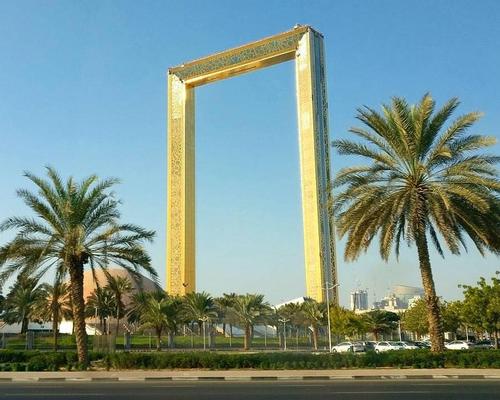03 Jan 2018
Public monument or postmodern pastiche? Towering Dubai Frame opens to public
BY Kim Megson

The world’s largest frame has opened in Dubai, offering a surreal and symbolic perspective of the emirate’s architectural landmarks.
The structure, which measures 150m (492ft) high and 93m (305ft) wide, is formed of two towers in Zabeel Park. The towers are connected by a 100sq m (1,076sq ft) bridge located 48 storeys above the ground, from which visitors can observe the surrounding cityscape. At ground level, the resultant rectangle frames towers including the Burj Khalifa – the world's tallest building.
The Dhs160m (US$43.5m, €36.2m, £32.3m) project, called the Dubai Frame, was originally designed by Mexican architect Fernando Donis following an international competition in 2009 – although he has claimed he was pushed aside following the win, with the building redesigned without him.
Elements incorporated since then include the golden-hued exterior, inspired by the logo of the Dubai Expo 2020.
In 2014, Donis warned in an open letter that “the project is being transformed from being non-figurative architecture to an overscale figurative photo frame... That is, from being a modern, public monument to a postmodern pastiche”.
In a recent interview with the Guardian, he said: “They took my project, changed the design and built it without me”, adding “[I] would like it to have been much more subtle, with less décor.”
However, he conceded in the same interview that the result “does precisely what I wanted” and “seems to work on the skyline exactly as we proposed”.
“It is fantastic to see it materialised,” he said.
The Dubai Municipality has previously claimed the Frame will attract as many as two million tourists a year, and a museum on the ground floor has opened showcasing Dubai’s transformation from fishing village to metropolis.
Starting from the mezzanine level, projections, mist effects, smells and motion evoke the feeling of being in old Dubai.
Visitors are taken up to the bridge’s partially glass-floored Sky deck to experience 360-degree views of the present Dubai, with augmented reality activated screens identifying buildings and landmarks.
Finally, they exit via the elevator onto the mezzanine floor and pass through a swirl tunnel with special audio and visual effects designed to create an illusion of time travel taking them into the city 50 years in the future.
A video tour of the new attraction can be viewed below:
Close Window